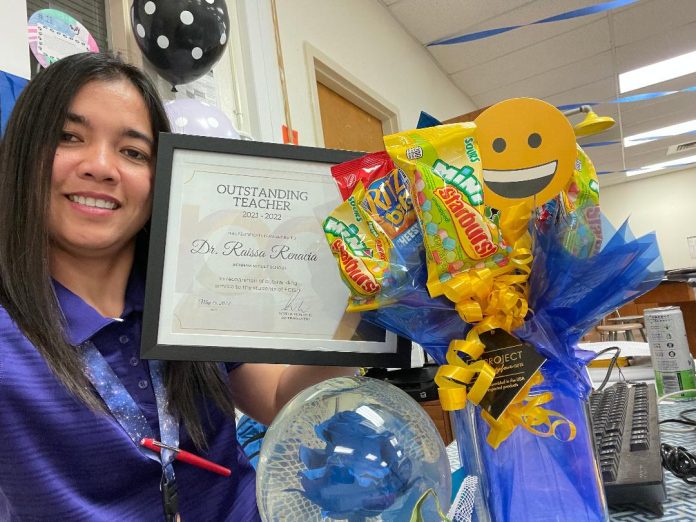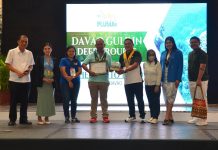“The mediocre teacher tells. The good teacher explains. The superior teacher demonstrates. The great teacher inspires.” ― William Arthur Ward
***
Every October 5, the global community observes World Teachers’ Day to celebrate the work of teachers, which are considered unsung heroes.
Teaching, after all, involves both conceptual and intellectual elements, blending abstract and concrete aspects, while also being creative and sequential in nature. It centers on every individual yet is articulated through ideas. It encompasses content, emotions, intellect, history, and future possibilities – essentially, whatever we can envision. Teaching and learning serve as both catalysts and outcomes.
Just like other professions, Filipino teachers are in demand abroad. Dr. Raissa Jara “Rj” C. Renacia is one of those who was given the opportunity to teach in the United States.
“I wanted to do something different,” who was a math teacher as the Senior High School Focus Person at San Jose Provincial High School in Negros Oriental for nine years. “Holding an administration position for a few years at a young age did not sound well to me. I wanted to stay in the classroom. However, my degree qualifies me to be promoted. I wanted to be in the classroom where I have a direct impact on my students.”
Rj believes she could do that in another country. She arrived in the US in October 2019 and was assigned to Odessa, Texas. Just like in the Philippines, she teaches mathematics. She was just adjusting with her new life when the pandemic happened.
“I was culture shocked,” she admitted. “I wasn’t ready for student behavior and how they perceived education as a whole. I was only teaching for a few months then COVID-19 happened. We had to switch from online classes to asynchronous classes.”
Imagine being away from the Philippines and the pandemic which was beyond the control of everyone. “For me, being away from home and seeing the news was terrifying,” she recalled. “I was afraid for my safety and the safety of the students I was tasked to teach. I
was struggling very much to help them learn because of the gap that was present before us.”
She met her students twice a week only and the rest was spent online. But as months passed by, she started to enjoy her new job. She was so good in what she was doing that in 2021, she was promoted as Master Team Reach Teacher (MTRT) because of her outstanding student data. More of this later on.
“I was able to have my students show growth during state tests (referring to the State of Texas Assessments of Academic Readiness or STAAR),” she said. “I helped turn the campus from an ‘F’ campus and was about to be taken over by the state to a ‘C’ campus. Bonham Middle School, the campus I have been teaching at is a Title 1 school, where 87% of the student population is described as ‘below average income.’”
It was a big challenge for her. She observed that the students I was assigned to teach didn’t want to learn. “Most of them think school was for making friends and hanging out with them,” she said. “The expectations were very low. At first, I felt all kinds of resistance from my students because they didn’t want to do work nor they wanted to be in the class. They just wanted to talk with their friends, be on their phones, sleep or eat.”
Rj is a different kind of teacher. She wanted to learn. “So, I told my students there was “No free day’ in mathematics. I made sure that I teach them every day. I had to make some innovative techniques for my class to be fun so that they would want to come and learn.”
Rj did what she described as “blended learning,” a technique she learned from attending the UTeach Professional Development, which her school district sponsored. She explained, “I created personalized learning plans for my students, online classroom management techniques like imagine math and sirius (math online platforms) where I purposely created a pathway for every student depending on their learning styles, prepared learning materials for both my students and the teachers I mentor since I am the only MTRT in the campus.”
She also used stations, where she had 5-6 offline activities for students who rotated inside the classroom. “I placed a timer on the board to let them know when it was time to rotate,” she said. “I made sure that I was consistent every day and had no days to slack off. As a result, my students were not just learning mathematics but they were also having fun while learning the subject.”

Because of what she did, she was named Bonham Middle School Teacher of the Year in 2022. “I was given this award because of the impact I made for both my students and the school,” Rj said. The year after, she was a State Recognized Teacher, under the Teacher Incentive Allotment (TIA) program because of her student growth scores during the state test (STAAR) and the MAP test.
“To be honest, I am not surprised to receive those recognitions,” she added. “I am a data driven person, so my lessons are always based on student data. I gather student results every day and align my lesson on gaps and state requirements. I also monitor the growth of my students. I design lessons and create individualized learning plans for them to be able to achieve higher. I am also very critical with my attendance and my Texas Teacher Evaluation and Support System (TTESS) evaluation, which also played a part in the recognition process.”
Right now, only around 3-4% of the teachers in Texas have received such accolades. “There were four of us who received the state recognition in the same year,” she said. “There are 76 total teachers in our school. However, I was the first internationally (foreign teacher) hired that got the recognition.”
Rj admitted that upon receiving the award, “I felt an overwhelming sense of gratitude and pride,” she said. “It was a validation of my hard work and dedication, not just for myself, but also for my students and colleagues who have supported me along the way. It reminded me of the impact I can make in education and inspired me to continue striving for excellence in the classroom.”
Her head and co-teachers were also proud of the accomplishment she had done in a very short span of time. “Everyone was happy,” she said. “Some teachers that teach a different subject approached me and asked for my help on how they can make their classes better and make their students perform.”
Today, Rj is one of the very few TIA recognized teachers in Texas, a feat for a Filipina teacher in the US. “I have a 96% rate in STAAR and 86% in MAP with a total growth percent of 91,” she disclosed. “The recognition is valid for 5 years and is printed on my State Standard teaching certification.”
To become an MTRT is a herculean task. A teacher needs to have at least three years of documented teaching experience with: high student growth in core content subjects (Elementary Education, Math, Science, Social Studies, English/Language Arts), then ratings in T-TESS Domains, and 3 correlated to high student academic achievement growth data.
Those are just for starters. There were several other requirements like the ability to navigate and disaggregate assessment data to drive instruction; ability to develop relationships and maintain consistent contact with students, parents, and colleagues; and strong organizational, communication, and interpersonal skills.
“The selection process is rigorous,” she said. “You have to submit all documents and undergo a series of interviews. Once the committee deemed you as qualified, you will be entered in a pool of qualified applicants where the principal themselves will select. You can be qualified but not necessarily get the position if a principal does not offer it to you.”
Rj was asked by five school principals. “They all offered me a position but I picked Bonham Middle School because this is my school and wanted to continue to serve the school and the community,” she said.
“I want to achieve 100% student growth, that is my goal,” she said. “I know being in a Title 1 school is already difficult but I also believe that I can help all my students succeed. If the student does not master the fundamentals of Math at an early age, proceeding to a higher Math would be very difficult. I want to address those gaps. These kids are our future! We need to take care of them and make sure they are ready for the future!”
When asked about her future plans, Rj replied, “I want to continue to teach inside the classroom and help students. I want to reach as many students as I can. Being an MTRT also helps me reach out to teachers and help them become advocates of student growth. That way the reach will be endless. I also want to help the international teachers in the school district. I have been coaching three international teachers (from Spain, Philippines and Turkey) as an MTRT. I have helped one of them get state recognition as well. I wanted to broaden my reach and help more international teachers get the recognition.”







